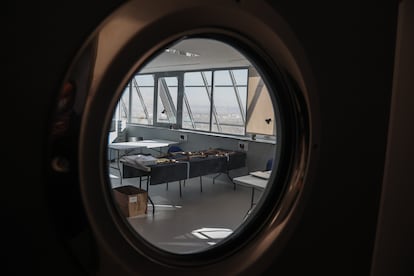Heidi Paz’s family awaits the release of her body four years after her death
The remains of the Honduran national have been stored in Madrid, Spain since 2018 amid legal challenges and delays in repatriation

The dark suitcase with silver trim in which Heidi Paz’s remains were discovered in Madrid on August 13, 2018, was present throughout the trial that ended wither her former partner being sentenced to 15 years for killing her. It was there, in a corner of the courtroom, like a silent witness against a defendant who wouldn’t stop talking: César Román, a former restaurant owner known by his nickname “the Cachopo King” after a type of meat dish from northern Spain. Four years later, the remains contained in that suitcase are still in a cold storage room awaiting a judicial order that allow Heidi’s family to finally put their trauma behind them. It is an exceptional case, even in the case of a violent death.
Heidi, who was 25 when she was killed, was born in San Pedro Sula in Honduras, one of the most violent cities in the world. That is where her family are awaiting her remains to give her a proper burial and afford her the dignity her killer tried to snatch away: Román was also sentenced for desecrating a corpse. Heidi’s arms, legs and head were never found and Román removed her breast implants to try and make identification more difficult. Part of her family still lives in Honduras, including her children. “The repatriation has been agreed with the embassy for some time, but we lack judicial permission to be able to remove the body, which will probably be cremated,” says the family’s lawyer, Alexis Socías.
Releasing the body of a victim of violent crime to a family is not minutely regulated, and as such depends on factors in the case investigation and trial, and on the sensitivity of the judges. In Heidi’s case, Román’s defense lawyers built their strategy on sowing doubt over the identification of the body. They questioned everything from the DNA tests to the color of the skin on the torso. “In photographs of Heidi, you can see that she was Black and these remains are white,” said defense lawyer Ana Isabel Peña of a body that had decomposed in the August sun and was full of caustic soda. A genetic test confirmed the relationship between the remains and Heidi’s mother.
The Cachopo King also argued during his appeal that his “basic rights had been violated.” This may explain why the judge upon who the decision depends has opted to exercise extreme caution until Román has exhausted all avenues of appeal: there is still the Spanish Supreme Court, a path which his lawyer has stated will be pursued despite the forcefulness with which all previous hearings have established his guilt. “For judicial purposes `the body] is just another piece of evidence, but for the family it is a loved one, and as such sometimes it is difficult to find a balance between ensuring guarantees for the parties and respecting the right to mourn and the beliefs of the family,” says Judge José Antonio Vázquez Taín, who faced criticism for being on the other side of a similar situation when he ordered the cremation of the remains of Asunta Basterra, a Spanish child whose parents were found guilty of her death in 2015.
“It is important to know how this process works and to bear in mind that second autopsies have more to do with Hollywood movies than reality. Normally, if it is necessary to carry out a review, it is sufficient to analyze the samples collected from the body during the initial autopsy. With current techniques you can even tell if the perpetrator put pressure on any part of the body by the state in which the molecules were left. We know everything,” says Vázquez Taín.
The judge also points out that some judges prefer to err on the side of caution and wait in case a new forensic method emerges in the course of time that can provide more definitive answers. This occurred in the case of Déborah Fernández-Cervera, who was found dead in northwestern Spain in 2002 and whose body was exhumed last year so that new tests that did not exist 20 years ago could be carried out. Thanks to these techniques, it was possible to extract DNA from underneath her fingernails.
A new appeal
The Paz family’s lawyer last week lodged a new request for the release of Heidi’s body after the regional High Court of Madrid (TSJM) confirmed Román’s sentence after studying his appeal. “More than a year ago we got a call from the Forensic Anatomical Institute to ask us what we were doing,” says Socías. Sources at the TSJM concur that the decision to release a body is taken on a case-by-case basis and that there is no general rule. “In this case we need to take into account that the perpetrator never confessed to the crime and the defense has always sowed doubt over the identification of the remains.” The same sources also note that the judge who presided the case and declared Román guilty, Araceli Perdices, has yet to receive the last document from the family asking for Heidi’s body to be released. “As soon as this is received, it will be transferred to the parties and, if nobody objects, a decision will be taken,” says the TSJM sources.
“It is true that four years is exceptional, it is likely the body that has spent the longest time in the facilities, but sometimes in cases that have received a lot of media coverage the magistrates prefer to be cautious and wait before allowing a burial,” say sources at the Institute of Legal Medicine in Madrid, which houses the Forensic Anatomical Institute. The Ruth and José Bretón case was one such example. The tiny remains of the siblings, who were six and two years old when they were killed and cremated in southern Spain by their father José Bretón, were also kept in storage until all avenues of appeal were exhausted and the sentence rubber-stamped, despite the requests of the children’s mother to let her bury them. “In my experience and based on what experts tell me, many families do not start to mourn until this moment occurs; it is a necessary step. Until that moment, many people even believe that this person could come back,” says Vázquez Taín.
On occasion, the return of mortal remains has provided a genuine problem. In a ruling in March 2020, the Supreme Court ruled against a magistrate in Valencia, in eastern Spain, noting that expediting procedures for the burial of a corpse is “a priority.” The reason for the ruling was the Discovery of a body in a car in Mislata, Valencia, in January 2017. A month later the police closed the case after ruling out any violent causes and confirming a suicide. But it was not until November that the magistrate released the body to the family.
The Supreme Court judges criticized the delay on the magistrate’s part, while she in turn pointed to her courtroom’s workload as justification. “From the moment a corpse ceases to be necessary for criminal proceedings, there is an inexcusable judicial duty to authorize burial or cremation. It is something that, precisely because corpses cannot remain without burial indefinitely, takes priority over practically any other action to be taken by the judge in question,” the ruling stated.
Meanwhile, Heidi’s body remains in storage at the Forensic Anatomical Institute in Madrid and her family are still awaiting her return to her homeland in a way they never expected.
Tu suscripción se está usando en otro dispositivo
¿Quieres añadir otro usuario a tu suscripción?
Si continúas leyendo en este dispositivo, no se podrá leer en el otro.
FlechaTu suscripción se está usando en otro dispositivo y solo puedes acceder a EL PAÍS desde un dispositivo a la vez.
Si quieres compartir tu cuenta, cambia tu suscripción a la modalidad Premium, así podrás añadir otro usuario. Cada uno accederá con su propia cuenta de email, lo que os permitirá personalizar vuestra experiencia en EL PAÍS.
¿Tienes una suscripción de empresa? Accede aquí para contratar más cuentas.
En el caso de no saber quién está usando tu cuenta, te recomendamos cambiar tu contraseña aquí.
Si decides continuar compartiendo tu cuenta, este mensaje se mostrará en tu dispositivo y en el de la otra persona que está usando tu cuenta de forma indefinida, afectando a tu experiencia de lectura. Puedes consultar aquí los términos y condiciones de la suscripción digital.
More information
Últimas noticias
Maduro pleads not guilty before the federal court in New York: ‘I am still the president of Venezuela’
A new test can detect Alzheimer’s from a finger prick
UN team enters Sudanese city of El Fasher after paramilitary massacre: ‘It’s like a ghost town’
A recipe for resistance: Indigenous peoples politicize their struggles from the kitchen
Most viewed
- Gilles Lipovetsky: ‘If you want to live better and fall in love, take Prozac, don’t look to philosophy’
- Alain Aspect, Nobel laureate in physics: ‘Einstein was so smart that he would have had to recognize quantum entanglement’
- Alvin Hellerstein, a 92-year-old judge appointed by Bill Clinton, to preside over Maduro’s trial in New York
- Why oil has been at the center of Venezuela-US conflicts for decades
- Cuba confirms death of 32 of its citizens in the US attack against Venezuela











































